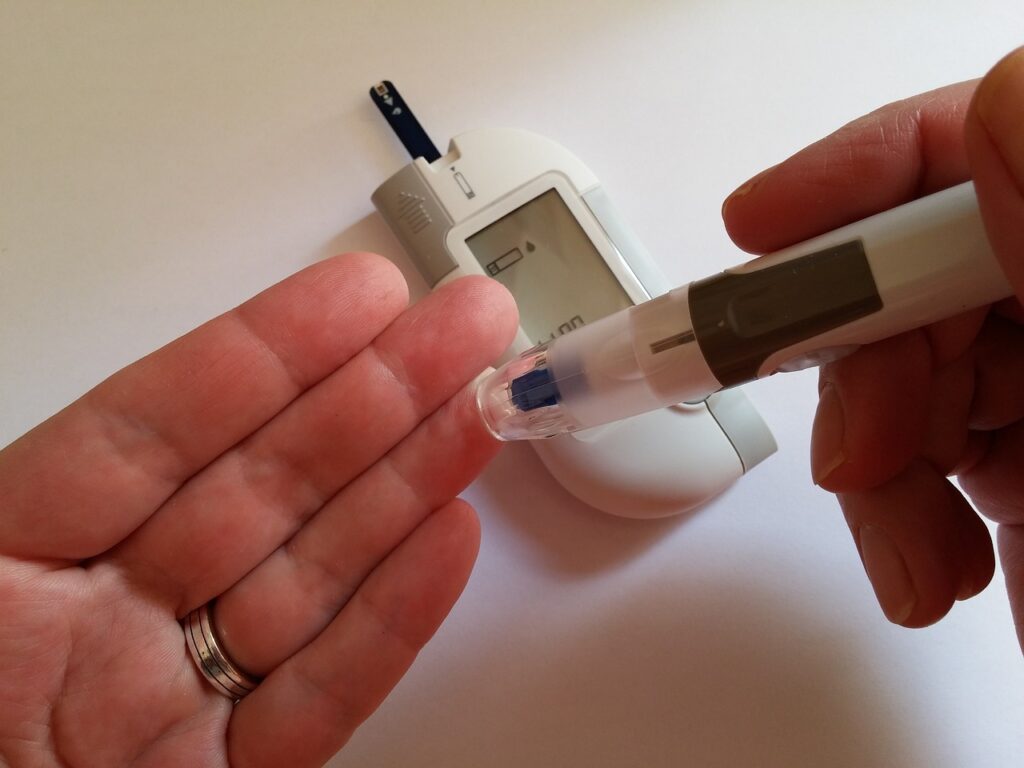Insulin is a hormone produced by the pancreas that plays a crucial role in regulating blood sugar levels in the body. It allows cells to absorb glucose from the bloodstream to use as energy. However, when the body becomes resistant to its own naturally produced insulin, a cascade of negative effects can occur, impacting overall health and increasing the risk of various medical conditions.
Insulin resistance is a condition where the body’s cells become less responsive to insulin’s effects, resulting in high glucose levels in the bloodstream. This leads to hyperglycemia, where cells cannot absorb glucose efficiently, causing fatigue and weakness. High blood sugar levels can damage blood vessels and organs, increasing the risk of developing various medical conditions.

Retinopathy, a condition resulting from diabetes and insulin resistance, can damage retina blood vessels, leading to vision problems and blindness. Foot problems, caused by nerve damage and poor circulation, can lead to foot ulcers and infections, potentially necessitating amputation.
In conclusion, insulin resistance disrupts the body’s ability to regulate blood sugar effectively and increases the risk of serious health complications. Addressing insulin resistance through lifestyle changes, medications, and regular monitoring is crucial to minimize its negative impact on overall health and well-being.
Contents
- 0.1 Understanding Insulin Resistance
- 0.2 Effects on Blood Glucose Levels
- 0.3 Development of Prediabetes and Type 2 Diabetes
- 0.4 Associated Conditions
- 0.5 Risk Factors for Insulin Resistance
- 0.6 Diagnosis and Screening
- 0.7 Prevention and Management Strategies
- 0.8 Complications and Long-Term Risks
- 0.9 Research and Future Developments
- 0.10 Living with Insulin Resistance
- 1 Conclusion
Understanding Insulin Resistance
Insulin resistance occurs when cells in the body become less responsive to the effects of insulin. This can happen due to a variety of factors, including genetics, obesity, sedentary lifestyle, and certain medical conditions. When cells are resistant to insulin, they require higher levels of insulin to absorb glucose, leading to elevated blood sugar levels.
Insulin resistance is a condition where the body’s cells become less sensitive to the effects of insulin, a hormone produced by the pancreas. Insulin is crucial in regulating blood sugar levels, as it helps cells break down carbohydrates into glucose, which enters the bloodstream. In cases of insulin resistance, cells don’t respond as effectively to insulin’s signal. Factors contributing to insulin resistance include genetic predisposition, obesity, sedentary lifestyle, and certain medical conditions.
Genetic predisposition can increase the likelihood of developing insulin resistance, especially when combined with other risk factors. Obesity can increase the release of fatty acids into the bloodstream, which interfere with insulin signaling, making cells less responsive to insulin over time. Sedentary lifestyle can also contribute to insulin resistance, as regular exercise improves insulin sensitivity and allows cells to absorb glucose more effectively.
When cells are resistant to insulin, they require higher levels of insulin to facilitate glucose uptake. The pancreas compensates by producing more insulin to maintain normal blood sugar levels, but this increased demand can eventually lead to insulin production becoming insufficient to overcome insulin resistance, resulting in elevated blood sugar levels.
High blood sugar levels, or hyperglycemia, can have detrimental effects on overall health. Understanding the factors contributing to insulin resistance and taking steps to address them through lifestyle changes, such as maintaining a healthy weight, staying physically active, and eating a balanced diet, is essential for preventing and managing this condition.
Effects on Blood Glucose Levels
One of the primary effects of insulin resistance is elevated blood glucose levels, known as hyperglycemia. Persistently high blood sugar levels can damage blood vessels and organs over time, increasing the risk of complications such as cardiovascular disease, kidney disease, and nerve damage.
Insulin resistance occurs when the body’s cells become less responsive to insulin, causing them to have difficulty absorbing glucose from the bloodstream. This results in hyperglycemia, which can have several detrimental effects over time.
1. Damage to blood vessels: High glucose levels can cause endothelial dysfunction, making blood vessels more susceptible to inflammation, plaque buildup, and narrowing, increasing the risk of cardiovascular diseases like heart attacks, strokes, and peripheral artery disease.

2. Increased risk of cardiovascular disease: Elevated blood sugar levels contribute to the development of atherosclerosis, a condition characterized by plaque buildup in arteries, restricting blood flow to vital organs and increasing the risk of heart disease, stroke, and other cardiovascular complications.
3. Kidney damage: High glucose levels can damage kidney vessels, leading to kidney disease or even failure, known as diabetic nephropathy.
4. Neuropathy: High blood sugar levels can damage nerves throughout the body, causing symptoms such as numbness, tingling, or pain, particularly in the hands and feet.
5. Eye problems (retinopathy): Diabetes and insulin resistance can damage blood vessels in the retina, leading to vision problems, including diabetic retinopathy, a leading cause of blindness in adults.
In conclusion, hyperglycemia resulting from insulin resistance has serious implications for overall health and increases the risk of developing various medical complications. Effective management of blood sugar levels through lifestyle changes, medications, and regular monitoring is crucial to minimize these risks.
Development of Prediabetes and Type 2 Diabetes
Insulin resistance is a significant risk factor for the development of prediabetes and Type 2 diabetes. When the pancreas can no longer produce enough insulin to overcome insulin resistance, blood sugar levels continue to rise, eventually leading to prediabetes and, if left untreated, Type 2 diabetes.
Insulin resistance is a significant factor in the development of prediabetes and Type 2 diabetes, two conditions linked to abnormalities in blood sugar regulation. Prediabetes is characterized by elevated blood sugar levels but not yet high enough to be diagnosed as Type 2 diabetes. Over time, the pancreas may struggle to keep up with the increased demand for insulin production, resulting in elevated blood sugar levels.
Type 2 diabetes occurs when the body either doesn’t produce enough insulin or becomes resistant to it, leading to chronically elevated blood sugar levels. This can lead to various complications if left untreated. Insulin resistance is often accompanied by other metabolic abnormalities, such as elevated blood lipids and increased abdominal fat deposition. These factors further contribute to the development of prediabetes and Type 2 diabetes by exacerbating insulin resistance and impairing glucose metabolism.

The progression from insulin resistance to prediabetes and Type 2 diabetes emphasizes the importance of early detection and intervention. Lifestyle modifications, such as adopting a healthy diet, increasing physical activity, and maintaining a healthy weight, can improve insulin sensitivity and prevent or delay the onset of these conditions. Additionally, medications like metformin may be prescribed to help lower blood sugar levels and reduce the risk of progression to Type 2 diabetes.
Associated Conditions
In addition to Type 2 diabetes, insulin resistance is associated with several other medical conditions, including:
Obesity
Obesity is closely linked with insulin resistance. Excess body fat, especially around the abdomen, can increase the release of fatty acids, which interfere with insulin signaling and contribute to insulin resistance.
Obesity is linked to insulin resistance, a condition characterized by the accumulation of excess body fat, particularly visceral fat, which disrupts normal metabolic processes, including insulin signaling. Obese individuals have enlarged and more metabolically active adipose tissue, leading to increased fatty acid release through lipolysis. Elevated levels of circulating fatty acids can interfere with insulin signaling pathways in muscle, liver, and other tissues, inhibiting insulin signaling and promoting insulin resistance.
Adipose tissue in obese individuals is also characterized by increased inflammation, with higher levels of pro-inflammatory cytokines like TNF-α and IL-6. Chronic low-grade inflammation contributes to insulin resistance by impairing insulin signaling and promoting the secretion of inflammatory mediators that interfere with glucose metabolism. Adipose tissue secretes hormones and cytokines that regulate metabolic function, but in obesity, adipokine secretion becomes dysregulated, leading to decreased production of adiponectin and increased production of pro-inflammatory adipokines. Addressing obesity through lifestyle modifications like diet, exercise, and weight loss interventions is crucial for improving insulin sensitivity and reducing the risk of metabolic complications, including Type 2 diabetes, cardiovascular disease, and non-alcoholic fatty liver disease (NAFLD).
Cardiovascular Disease
Insulin resistance is a significant risk factor for cardiovascular disease, including heart attacks, strokes, and peripheral artery disease. High levels of insulin in the blood can lead to inflammation and damage to blood vessels, increasing the risk of atherosclerosis and other cardiovascular complications.
Insulin resistance is a significant risk factor for cardiovascular disease, affecting the heart and blood vessels. It contributes to the development of atherosclerosis, a condition characterized by plaque buildup in arteries. Insulin resistance leads to higher insulin levels in the bloodstream, which can stimulate the growth of smooth muscle cells and the production of inflammatory molecules, leading to plaque formation.
Endothelial dysfunction is another risk factor, as insulin resistance can impair the function of the endothelium, the inner lining of blood vessels. This dysfunction leads to vasoconstriction, inflammation, and increased permeability, promoting the development of atherosclerosis and increasing the risk of cardiovascular events.

Inflammation is another risk factor, with elevated levels of inflammatory markers such as C-reactive protein, IL-6, and TNF-α contributing to endothelial dysfunction, plaque formation, and instability. Inflammation plays a key role in all stages of atherosclerosis, from immune cell recruitment to the formation of complex plaques that can rupture and cause acute cardiovascular events.
Dyslipidemia, characterized by elevated triglycerides, decreased high-density lipoprotein cholesterol, and a shift toward smaller, denser LDL particles, is another risk factor. Insulin resistance is also associated with hypertension, which increases the risk of cardiovascular disease by promoting sodium retention and vasoconstriction in the kidneys.
Risk Factors for Insulin Resistance
Several factors increase the risk of developing insulin resistance, including:
Insulin resistance is a condition characterized by a lack of insulin sensitivity, glucose metabolism, and the function of insulin-signaling pathways. Genetics play a significant role in this condition, with a family history of Type 2 diabetes or insulin resistance increasing the risk. Lifestyle factors, such as sedentary lifestyle, poor diet, and obesity, also contribute to the development of insulin resistance.
Sedentary lifestyles, which involve lack of physical activity and exercise, can enhance insulin sensitivity by promoting glucose uptake into skeletal muscle cells and improving mitochondrial function. Conversely, sedentary behavior reduces energy expenditure, increases visceral adiposity, and impairs insulin action, increasing the risk of insulin resistance.
Poor diets, high in refined carbohydrates, added sugars, and saturated fats, can promote insulin resistance by causing rapid blood sugar spikes, increasing lipid accumulation, and inducing inflammation. Conversely, diets rich in fiber, whole grains, fruits, vegetables, and lean proteins promote insulin sensitivity and metabolic health.
To reduce the risk of insulin resistance and Type 2 diabetes, individuals should address modifiable lifestyle factors such as increasing physical activity, adopting a balanced diet, and maintaining a healthy weight.
Diagnosis and Screening
Diagnosing insulin resistance typically involves blood tests to measure fasting insulin levels and glucose tolerance. Additionally, healthcare providers may assess risk factors such as waist circumference, body mass index (BMI), and family history of diabetes.
Insulin resistance is a condition that can be diagnosed through a combination of laboratory tests and risk factors assessment. Blood tests, such as fasting insulin levels and glucose tolerance tests, can be used to measure insulin resistance. Insulin resistance may be characterized by impaired glucose tolerance, higher-than-normal blood glucose levels after consuming glucose, and elevated hemoglobin A1c (HbA1c), which may indicate poor glycemic control and insulin resistance or diabetes.
Anthropometric measurements, such as waist circumference and body mass index (BMI), can also be used to identify individuals at higher risk. Obesity, sedentary lifestyle, poor dietary habits, ethnicity, age, and certain medical conditions can also contribute to insulin resistance.
A family history of diabetes or insulin resistance is a significant risk factor for insulin resistance. Healthcare providers may inquire about the presence of diabetes or other metabolic conditions among close relatives. Other risk factors for insulin resistance include obesity, sedentary lifestyle, poor dietary habits, ethnicity, age, and certain medical conditions.
A comprehensive evaluation that considers both laboratory test results and clinical risk factors is essential for early detection of insulin resistance. This allows for timely intervention through lifestyle modifications, medications, and regular monitoring to prevent or delay the onset of Type 2 diabetes and reduce the risk of associated health complications.
Prevention and Management Strategies
Preventing and managing insulin resistance involves a combination of lifestyle modifications, medications, and regular monitoring.
Preventing and managing insulin resistance requires a comprehensive approach that addresses various lifestyle factors and may involve medical interventions. Lifestyle modifications include adopting a healthy diet, engaging in regular physical activity, managing weight, stress management, and getting adequate sleep. A balanced and nutritious diet, including whole foods, fruits, vegetables, whole grains, lean proteins, and healthy fats, is essential for maintaining a healthy weight and blood sugar levels. Regular physical activity can improve insulin sensitivity and prevent insulin resistance. Weight management is crucial as excess body fat, particularly abdominal fat, contributes to insulin resistance and metabolic dysfunction.
Stress management is essential for maintaining insulin sensitivity and disrupting hormonal balance. Practice stress-reducing techniques such as mindfulness meditation, deep breathing exercises, yoga, tai chi, or engaging in hobbies and activities you enjoy. Prioritize self-care and make time for relaxation and leisure activities.
Adequate sleep is essential for metabolic health and insulin sensitivity. Aim for seven to nine hours of sleep per night and maintain a consistent sleep schedule. Create a relaxing bedtime routine, avoid stimulants like caffeine and electronics before bed, and create a comfortable sleep environment conducive to restorative sleep.
Medications and medical interventions may include metformin, which reduces glucose production in the liver, improves insulin sensitivity in peripheral tissues, and enhances glucose uptake by muscle cells. Other medications may be prescribed to improve glycemic control and insulin sensitivity in individuals with insulin resistance or Type 2 diabetes. Regular monitoring of blood sugar levels is essential for tracking glycemic control and making necessary adjustments to treatment plans.
Regular check-ups with healthcare providers are essential for assessing overall health, monitoring blood pressure, cholesterol levels, kidney function, and other relevant parameters. Your healthcare provider will evaluate your response to treatment, make adjustments to your medication regimen if necessary, and provide ongoing support and guidance to help you manage insulin resistance effectively.
Dietary Recommendations
A balanced diet rich in fruits, vegetables, whole grains, and lean proteins can help improve insulin sensitivity and regulate blood sugar levels. Avoiding sugary foods, refined carbohydrates, and excessive saturated fats is also important.
Dietary recommendations are crucial in managing insulin resistance and promoting overall metabolic health. To achieve this, it is essential to emphasize whole foods, including fruits, vegetables, whole grains, lean proteins, sugary drinks, sweets, and processed snacks. Fruits are rich in vitamins, minerals, antioxidants, and fiber, while vegetables are low in calories and high in fiber, vitamins, and minerals. Whole grains, such as brown rice, quinoa, barley, oats, and whole wheat bread and pasta, are higher in fiber and nutrients compared to refined grains, helping promote satiety and stabilize blood sugar levels.
Lean protein sources like poultry, fish, tofu, legumes, beans, lentils, and low-fat dairy products can help build and repair tissues, support muscle health, and promote feelings of fullness, aiding in weight management. Limiting sugary foods and refined carbohydrates, such as sodas, fruit juices, sports drinks, and sweetened teas and coffees, is also important. Instead, choose healthier alternatives like fresh fruit, yogurt with berries, or homemade fruit sorbet.
When choosing whole grains, replace white bread with whole wheat bread, white rice with brown rice or quinoa, and processed snacks with whole food options like nuts, seeds, or air-popped popcorn. It is also important to watch your fat intake, choosing healthy fats in moderation and limiting saturated and trans fats, which can contribute to inflammation and insulin resistance. Incorporate healthy fats like avocados, nuts, seeds, olive oil, and fatty fish into meals for omega-3 fatty acids, anti-inflammatory properties, and heart health support. Reduce the consumption of saturated fats found in red meat, processed meats, full-fat dairy products, and fried foods, and avoid trans fats found in partially hydrogenated oils, fried foods, and commercially baked goods.
Practicing portion control and mindful eating can help prevent overeating and promote satiety. Eat slowly, savor each bite, and listen to your body’s hunger and fullness cues. A balanced diet, combined with regular physical activity, stress management, and adequate sleep, can help prevent and manage insulin resistance effectively.
Exercise and Physical Activity
Regular physical activity is crucial for improving insulin sensitivity and reducing the risk of insulin resistance and Type 2 diabetes. Aim for at least 150 minutes of moderate-intensity exercise per week, along with strength training exercises.
Exercise and physical activity are crucial for improving insulin sensitivity, managing weight, and reducing the risk of Type 2 diabetes. To achieve this, aim for at least 150 minutes of moderate-intensity aerobic exercise per week, including activities like walking, cycling, swimming, dancing, and recreational sports. These activities can help lower blood sugar levels, improve insulin sensitivity, and enhance cardiovascular health. Regular aerobic exercise also helps with weight management, reduces inflammation, and lowers the risk of developing Type 2 diabetes and cardiovascular disease.
Incorporate strength training exercises into your routine at least two days per week, such as weightlifting, bodyweight exercises, resistance band workouts, or using weight machines at the gym. Strength training builds muscle mass and increases muscle strength, which can improve insulin sensitivity and glucose metabolism. Muscle tissue is more metabolically active than fat tissue, so having more muscle helps burn more calories and maintain a healthy weight. Additionally, strength training can prevent age-related muscle loss and preserve bone density.
Incorporating flexibility and balance exercises in your routine can help maintain joint mobility, prevent injury, and improve overall functional fitness. Yoga, Pilates, tai chi, and gentle stretching exercises can help improve flexibility, balance, and coordination. These exercises also promote overall mobility, reduce stress, promote relaxation, and enhance mind-body awareness.
To ensure long-term benefits, start with activities that you enjoy and gradually increase the duration, intensity, and frequency of your workouts over time. Make physical activity a regular part of your daily routine by scheduling workouts at convenient times and setting realistic goals. Mix up your workouts by incorporating different types of aerobic exercises, strength training routines, and recreational activities to keep boredom at bay and prevent plateauing.
By incorporating regular aerobic exercise, strength training, flexibility, and balance exercises into your routine, you can improve insulin sensitivity, manage weight, and reduce the risk of Type 2 diabetes. Consult with your healthcare provider before starting any new exercise program.
Complications and Long-Term Risks
Untreated insulin resistance can lead to various complications, including:
Insulin resistance is a serious health issue that can lead to chronically elevated blood sugar levels, increasing the risk of chronic diseases such as Type 2 Diabetes, cardiovascular disease, and other complications. Type 2 diabetes is characterized by high blood sugar levels due to inadequate insulin production or impaired insulin function, and can progress to prediabetes and eventually Type 2 diabetes if left untreated.
Cardiovascular disease is a major risk factor for insulin resistance, contributing to endothelial dysfunction, inflammation, dyslipidemia, and atherosclerosis. It can lead to serious complications such as heart attacks, strokes, heart failure, and peripheral vascular disease. Addressing insulin resistance and its associated risk factors is crucial for preventing these complications.
Other complications include hypertension, non-alcoholic fatty liver disease (NAFLD), and polycystic ovary syndrome (PCOS). Hypertension is associated with an increased risk of cardiovascular disease and other complications. NAFLD, a non-alcoholic fatty liver disease, can progress to more severe liver conditions such as NASH and cirrhosis if left untreated. PCOS is a hormonal disorder that affects reproductive health in women, and insulin resistance is a hallmark feature of this disorder.
To prevent or delay the onset of Type 2 diabetes, reduce the risk of cardiovascular disease, and minimize the potential for associated complications and long-term health risks, it is essential to address insulin resistance through lifestyle modifications, medications, and regular monitoring. Early detection and intervention are key to managing insulin resistance effectively and improving overall health outcomes.
Research and Future Developments
Ongoing research is focused on better understanding the underlying mechanisms of insulin resistance and developing more effective treatments. Potential future therapies may include novel medications, gene therapies, and lifestyle interventions. Insulin resistance is a growing concern in the fight against Type 2 diabetes and its associated complications. Researchers are exploring the molecular and cellular mechanisms of the condition, using advances in molecular biology, genetics, and bioinformatics to identify novel genes, signaling pathways, and molecular targets. Genetic studies are using genome-wide association studies and genetic sequencing techniques to identify genetic variants associated with insulin resistance and Type 2 diabetes.
Therapeutic targets are being explored, including small molecule drugs, biologics, and gene therapies. Pharmaceutical companies are developing novel medications targeting insulin resistance and related metabolic disorders. Lifestyle interventions, including diet, exercise, weight management, stress reduction, and sleep hygiene, are also being explored. Precision medicine is revolutionizing the treatment of insulin resistance by tailoring therapies to individual genetic, metabolic, and lifestyle factors. Clinical trials are crucial for evaluating the safety and efficacy of new therapies.
Living with Insulin Resistance
Living with insulin resistance requires making long-term lifestyle changes to manage blood sugar levels and reduce the risk of complications. This may include adopting a healthy diet, engaging in regular physical activity, monitoring blood sugar levels, and taking medications as prescribed.
Living with insulin resistance requires a balanced diet, mindful eating, regular meals, and carbohydrate management. Regular physical activity, such as aerobic exercise, strength training, and flexibility exercises, can improve insulin sensitivity and overall health. Regular self-monitoring and record keeping are essential for managing blood sugar levels. Consistent medication adherence and open communication with healthcare teams can help adjust treatment plans.
Stress management techniques like deep breathing, meditation, yoga, and nature can promote well-being. A healthy work-life balance is crucial to prevent burnout and maintain emotional resilience. A support system can be found in family and friends, as well as online communities. By adopting a proactive approach and seeking support when needed, individuals can optimize their health and well-being while minimizing the impact of insulin resistance on their life.
Conclusion
Insulin resistance is a significant challenge in metabolic health, but with awareness and proactive lifestyle changes, its adverse effects can be mitigated. It serves as a precursor to more severe conditions like Type 2 diabetes and cardiovascular disease. Adopting healthy lifestyle habits like maintaining a balanced diet, regular physical activity, monitoring blood sugar levels, and adhering to prescribed medications can effectively manage insulin resistance. Fostering a supportive environment and sharing experiences can also help. Embracing education, adopting healthy habits, and seeking support can help individuals manage insulin resistance and safeguard their long-term health.
FAQs:
- Can insulin resistance be reversed?
- With lifestyle changes such as diet and exercise, insulin resistance can often be improved or even reversed in the early stages.
- Is insulin resistance the same as diabetes?
- Insulin resistance is a precursor to Type 2 diabetes, but not everyone with insulin resistance will develop diabetes.
- Are there medications available to treat insulin resistance?
- Yes, several medications, including metformin and thiazolidinediones, are used to improve insulin sensitivity and manage blood sugar levels.
- Can insulin resistance be prevented?
- Adopting a healthy lifestyle, including regular exercise and a balanced diet, can help prevent or delay the onset of insulin resistance.
- Is insulin resistance hereditary?
- Genetics can play a role in insulin resistance, so having a family history of diabetes or insulin resistance may increase your risk. However, lifestyle factors also significantly influence its development.
Give my new GPT a try: https://bit.ly/Jumma_GPTs
Get Access Now: https://bit.ly/J_Umma

